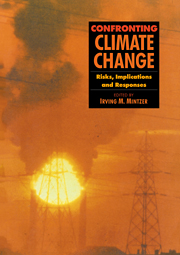Book contents
- Frontmatter
- Contents
- Foreword
- Acknowledgements
- List of Reviewers
- 1 Living in a Warming World
- I The Science of Climate Change
- II Impacts of Global Climate Change
- III Energy Use and Technology
- 12 The Energy Predicament in Perspective
- 13 Electricity: Technological Opportunities and Management Challenges to Achieving a Low-Emissions Future
- 14 Transportation in Developing Nations: Managing the Institutional and Technological Transition to a Low-Emissions Future
- IV Economics and the Role of Institutions
- V Equity Considerations and Future Negotiations
- Annex I
- Annex II
- Glossary
- Index
14 - Transportation in Developing Nations: Managing the Institutional and Technological Transition to a Low-Emissions Future
Published online by Cambridge University Press: 06 January 2010
- Frontmatter
- Contents
- Foreword
- Acknowledgements
- List of Reviewers
- 1 Living in a Warming World
- I The Science of Climate Change
- II Impacts of Global Climate Change
- III Energy Use and Technology
- 12 The Energy Predicament in Perspective
- 13 Electricity: Technological Opportunities and Management Challenges to Achieving a Low-Emissions Future
- 14 Transportation in Developing Nations: Managing the Institutional and Technological Transition to a Low-Emissions Future
- IV Economics and the Role of Institutions
- V Equity Considerations and Future Negotiations
- Annex I
- Annex II
- Glossary
- Index
Summary
Editor's Introduction
The world is caught in a seemingly insolvable dilemma. On one hand, in both industrialized and developing countries, consumers are increasingly demanding mobility—both for themselves and for goods from far away. The most convenient, and in many cases most desired solution is transport by motor vehicles. But as Jayant Sathaye and Michael Walsh note in this chapter, increasing motor vehicle use inevitably leads to a range of air pollutant emissions to the atmosphere —along with congestion and inefficient use of fuel. These in turn exacerbate both environmental and economic problems. As developing countries become more urbanized and increasingly dependent on cars and trucks, they will confront the linked problems of heavy traffic, urban pollution, high accident rates and low vehicle efficiencies. These developments suggest to Sathaye and Walsh that there is a growing need for new and more sustainable transportation strategies.
Unfortunately, the trend is in the opposite direction. Sathaye and Walsh document how desires for mobility in developing countries have already brought forth a conventional vehicle fleet that is dependent on liquid fuels — principally oil. Expanding industrial markets spur demands for motorized freight transport. As economies grow, freight transport traditionally shifts modes —from rail to roads and air. The gradual movement away from non-motorized transport—which depended on animal carts, bicycles, and people on foot—toward increasing reliance on cars, buses, and trucks has led to multipurpose use of roads with consequent increases in congestion, risks of collisions, and decreases in fuel efficiency.
- Type
- Chapter
- Information
- Confronting Climate ChangeRisks, Implications and Responses, pp. 195 - 216Publisher: Cambridge University PressPrint publication year: 1992
- 3
- Cited by

